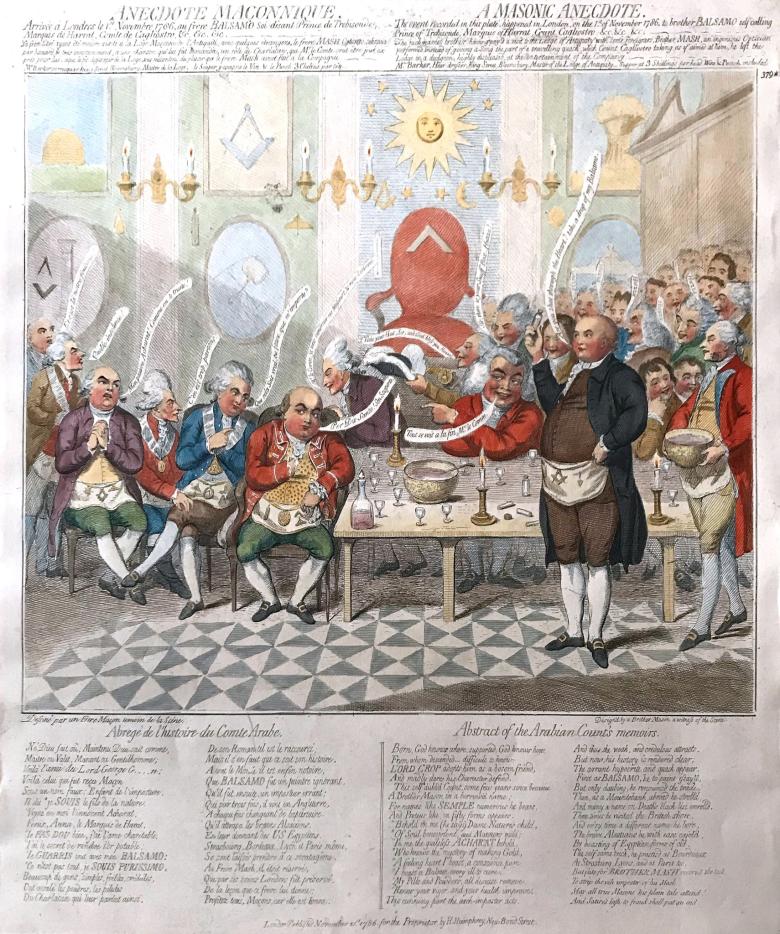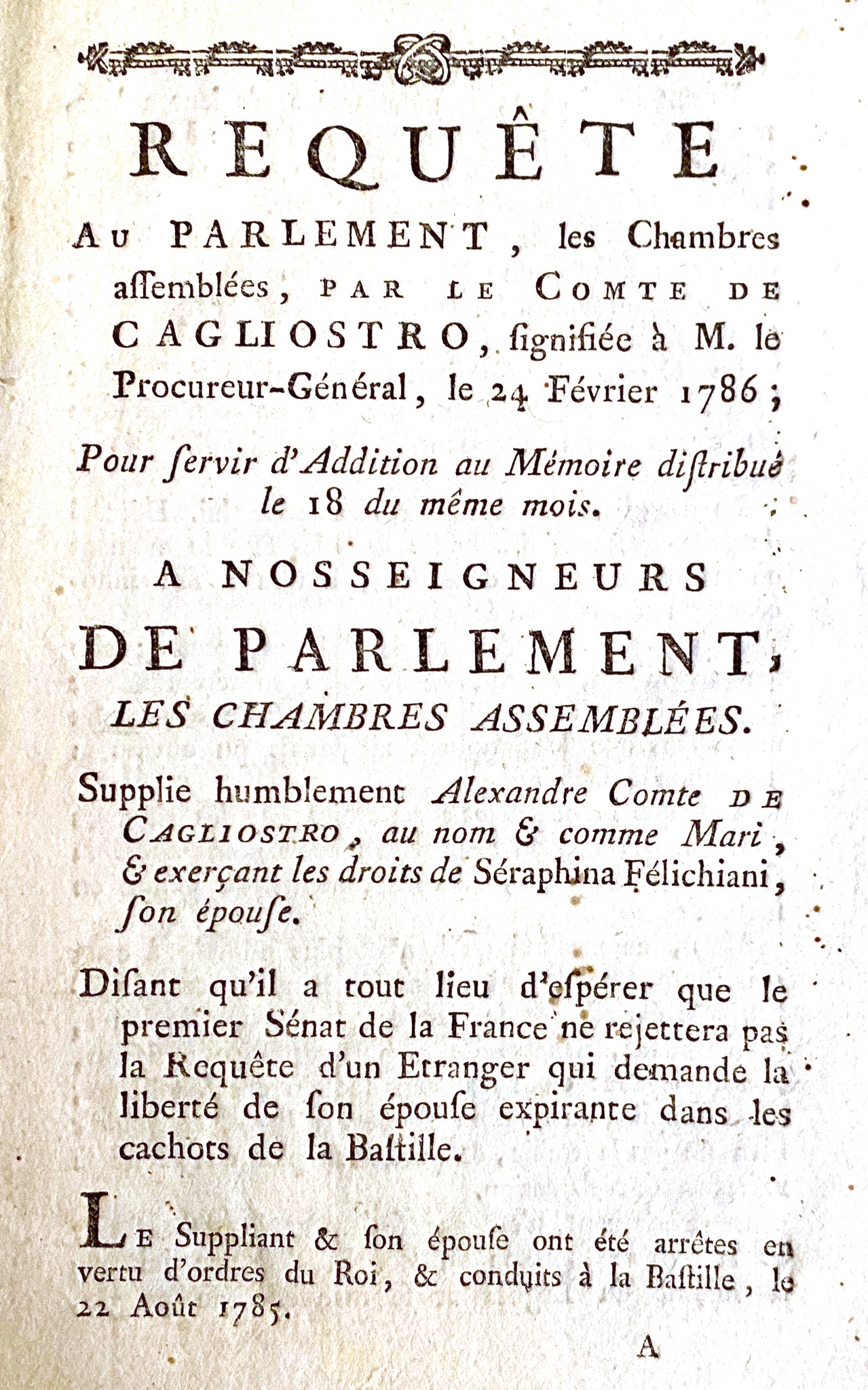Cagliostro and Ancient Egyptian Freemasonry


Some of our latest news
Cagliostro and Ancient Egyptian Freemasonry
Alessandro Cagliostro (1743-1795) is one of the most enigmatic and scandalous figures of the 18th century. Declaring himself an alchemist and magician, as well as joining Freemasonry, Cagliostro left behind a very contradictory trail: he was either honoured as an outstanding esotericist and sage, or condemned as a charlatan. In Cagliostro's biography, a fateful role was played precisely in Mitau (modern Jelgava, Latvia), where he reached the peak of his fame, but was later exposed in his fraudulent activities. Despite his scandalous reputation, Cagliostro became a kind of symbolic embodiment of the 18th century intelligentsia, with a passion for secret knowledge and a desire to create closed societies.
Cagliostro's real name was Giuseppe Balsamo, and he was supposedly born in Palermo, Sicily, in 1743 to an impoverished family. Balsamo's father died early and his mother struggled to provide for the family, sending Balsamo to study at a Catholic church where he learnt to read, write and learned Latin. Also at the church school he learnt the basics of maths, chemistry and medicine. The young Balsamo showed an early interest in the occult and alchemy, probably after reading Renaissance literature on alchemy and astrology, which was available in the libraries of local Sicilian monasteries.
Balsamo committed his first crime in Sicily in 1764 when he persuaded a jeweller acquaintance, Vincenzo Marano, to go on an expedition to Mount Pellegrino near Palermo. According to Balsamo, under the mountain was an ancient treasure, guarded by magical creatures, against which he knew secret spells. Also, under the pretext of a protection against evil forces, he had persuaded the jeweller to take a lot of money with him. When they reached the supposed place of the treasure, Marano received from Balsamo a strong blow to the head and lost consciousness. When he woke up, he learnt that Balsamo had robbed him and fled to Messina and soon left Sicily for Rome.
It is believed that sometime between 1764 and 1768, Balsamo invented the pseudonym Alessandro Cagliostro, forging documents and assuming the title of Count. In 1768 Cagliostro married Lorenza Feliciani (1751-1794) and began working in Roman pharmacies. In Rome, Cagliostro became close friends with a rogue calling himself the Marquis de Alietta, who had been convicted several times for forging documents and stealing money. Cagliostro and Alietta together invented the legend that they had visited Egypt where they had obtained secret knowledge. In particular, Cagliostro himself began to claim that he personally met with the deity Hermes Trismegistus and solved ancient Egyptian mysteries. Such stories attracted people, and many intellectuals believed Cagliostro's words, despite the fact that the ancient Egyptian language and script were deciphered only in 1822.
Due to a major forgery of documents and the threat of arrest, Cagliostro fled to Lisbon, Portugal. Here he met the British and decided to go to London, where he claimed to have learnt the secrets of immortality in Egypt, and began selling elixirs which, according to him, slowed down aging. It is known that Cagliostro was admitted to the Espérance Masonic Lodge No. 289 in London in early 1777. In London, Cagliostro began to claim that he could communicate with the souls of the deceased and sold stones that «had magical powers».
In 1778, he went to France, and then travelled in what is now Germany, where he actively spread the «Egyptian rite» - rituals and symbolism with an ancient Egyptian theme, allegedly borrowed from the Egyptian mysteries. Most Freemasons rejected Cagliostro's teachings, calling him a major fraudster and accusing him of fraud.
However, Cagliostro's stay in Mitau was particularly successful. Arriving in the capital of the Duchy of Courland in early 1779, Cagliostro charmed the local nobleman Christopher Georg von Medem, master of the Mitau Masonic lodge «At the Three Crowned Swords» («Zu den drei Gekrönten Schwerdtern»), and his niece Elise von der Rekke, who even fell in love with Cagliostro.
In Mitau, Cagliostro was almost immediately accepted into Medem’s Masonic Lodge and began conducting spiritistic séances and selling magic stones and elixirs of immortality. He claimed that his real age was over 2000 years old and that he was an ancient Roman who had solved the ancient Greek mysteries and received the gift of immortality. During the same period, Cagliostro founded his own adaptive lodge «Three Crowned Hearts» («Loge d’Adoption des trois Cœurs couronnés»), with an ancient Egyptian theme, which admitted both men and women.
At first, Cagliostro enjoyed great popularity and trust of the locals, who were delighted by his magical performances. The memories of the townspeople of Mitau about Cagliostro's miracles have survived to this day. For example, Cagliostro told people that the archangel Michael appeared to him, which that day supposedly helped a local nobleman and his unbelieving son to believe in God. Also, locals often spoke of Cagliostro's paranormal clairvoyance ability and his ability to see events at a distance.
But it was in Mitau that Cagliostro was first publicly exposed. It happened during another spiritualistic séance, when Cagliostro allegedly communicated with the souls of the dead. After the séance, Count Medem's minor nephew confessed that Cagliostro had told him to give memorised answers to questions before the séance, completely exposing his ability to communicate with the souls of the dead. This allowed Elise von der Rekke to write a book «Description of the stay in Mitau of the famous Cagliostro in 1779 and the magical actions he performed there, collected by Charlotte-Elizabeth von der Rekke, born Countess of Medem», which exposed the activities of the famous adventurer.
In 1780, Cagliostro left Mitau in a hurry and headed for Saint Petersburg, determined to gain the confidence of Empress Catherine II and infiltrate the royal court. However, Elise von der Rekke corresponded with the Empress and managed to warn her about Cagliostro in advance. In fact, this was the beginning of the end of the famous charlatan.
In St. Petersburg, Cagliostro managed to get acquainted with the famous Freemason - the first Grand Master of Russia, Ivan Yelagin, as well as with Count and Field Marshal Gregory Potemkin. However, Cagliostro was quickly exposed as a fraud, particularly over the sale of counterfeit jewellery. He then left St. Petersburg, living in the capital of the Russian Empire for only 9 months. Cagliostro's activities later formed the basis of the comedy play «The Deceiver», composed personally by Catherine the Great.
After St. Petersburg, Cagliostro travelled via Mitau to Warsaw, where he perpetrated a particularly large scam. Initially, Cagliostro gained the trust of Warsaw nobles who wanted to learn the secrets of immortality. He founded a Masonic lodge with an ancient Egyptian theme, similar to the lodge in Mitau. Cagliostro said that within three weeks he will conduct an alchemical transmutation - turn base metals into gold and silver. On the announced day, it turned out that Cagliostro had escaped from Warsaw, stealing an extremely large amount of gold and jewellery from the enticed people.
Then Cagliostro moved to Strasbourg, where he also founded a Masonic lodge, and later went to Paris, where in 1784 became a participant in the scam with the necklace of Marie Antoinette. The essence of the case was that Cagliostro assisted fraudster Jeanne de Lamotte, who convinced Cardinal Louis de Rogan that Queen Marie Antoinette allegedly wanted to buy an expensive diamond necklace, but could not do it openly. Rogan, eager to earn the queen's favour, entered into the transaction, but eventually discovered that he had been deceived. Cagliostro, a close acquaintance of Cardinal Rogan, was arrested on charges of fraud, but was later acquitted. During the trial he denied his involvement in the scam, but the scandal had already dealt a serious blow to his reputation. This case actually strengthened the public image of Cagliostro as the main adventurer in Europe.
The final stop for Cagliostro was Rome, where he was arrested in 1789 after attempting to found a Masonic lodge. This accusation was only a pretext for the arrest of the self-proclaimed Count, who made so many enemies across Europe that it allowed Cagliostro to be tried in his native lands. He was quickly accused of particularly large frauds and sentenced to death, but Pope Pius VI commuted the sentence to life imprisonment at the last moment before his execution. Cagliostro was imprisoned in the castle of San Leo, in the Emilia-Romagna region, where he died in 1795. Researchers believe that the local authorities allowed Cagliostro to be poisoned at the request of his deceived victims.
Despite his controversial reputation, Cagliostro's influence can still be found to this day. Even during his lifetime, he became the hero of many literary works, and in the 19th century his image was used by such classics of world literature as Alexandre Dumas, Alexei Tolstoy, Mikhail Kuzmin and Umberto Eco.
Modern scholars of Freemasonry believe that Cagliostro was one of the first to popularise ancient Egyptian themes within the fraternity. In the 18th century, rituals based on lost ancient Egyptian wisdom were speculative and cosmetic in nature. But with the development of Egyptology and the unravelling of Egyptian writing, the image of ancient Egypt, including deities and traditions, took on an increasingly deep philosophical character. As Egyptian hieroglyphics were deciphered in France, it was here that the «Oriental Rite of Memphis» was formally established in the first half of the nineteenth century. This was the impetus for the opening of Masonic lodges with ancient Egyptian themes throughout Europe and the United States.
The Egyptian charter in Freemasonry was finally approved by the military leader and unifier of modern Italy, Giuseppe Garibaldi, who founded the «The Ancient and Primitive Rite of Memphis-Misraim» in 1881. This Masonic rite still exists today and is under the jurisdiction of the Grand Orient of France. It is one of the most esoteric Masonic rites and is based on ancient Egyptian mythology, Hermetic and Kabbalistic ideas, and includes up to 99 degrees of initiation. It is important to note that Egyptian and Oriental symbolism in the rituals, as well as references to ancient Egyptian deities such as Isis, Horus and Osiris, do not contradict the basic principles of Freemasonry. «The Rite of Memphis-Misraim» is based on common humanistic ideals along with the rest of Masonic charters, and ancient Egyptian symbolism serves as one of the tools for the transmission of philosophical knowledge and the development of human morality.
Items from the museum collection:
Petition to the French Parliament and the Defense Memorandum of Count Cagliostro, 1786; Satirical engraving "Count Balsamo Selling Balms in the Lodge of Antiquity," James Gillray, England, 1786.

 Museum
Museum